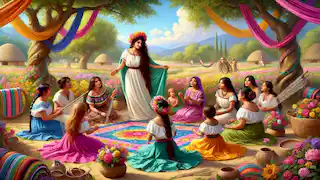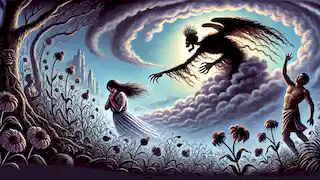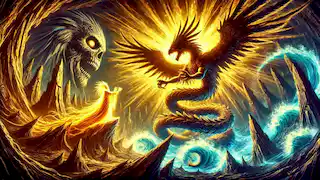High in the heavens of Mesoamerican mythology, the gods and goddesses of the ancient Mexica people held their councils and shaped the world below. Among the pantheon, Xochiquetzal, the goddess of beauty, love, fertility, and flowers, stood out for her unparalleled grace and charm. As the embodiment of feminine power, she was both nurturing and enchanting, a protector of women and a patron of artists and artisans. Her tale is one woven with the vibrancy of life and the bittersweet nature of love and sacrifice. In this story, we dive deep into the mythology surrounding Xochiquetzal, exploring her creation, her journey, and the powerful lessons she left behind for the people of Mexico. Long ago, when the world was still young and the land of Anahuac was filled with verdant valleys and mighty volcanoes, the gods gathered in the celestial city of Tamoanchan to create a being that would personify the earth’s most radiant qualities. Quetzalcoatl, the Feathered Serpent, and the creative force behind many of the gods' works, took the task upon himself. With his divine power, he reached into the depths of the cosmos and collected the essence of flowers, the shimmering hues of butterflies, and the sweet fragrance of the earth after rain. From these elements, Quetzalcoatl molded a form unlike any seen before. As he breathed life into the figure, she opened her eyes, and her beauty illuminated the heavens. The other gods gazed in awe, for this being was more than just a goddess—she was the essence of all that was beautiful and good in the world. She was Xochiquetzal, whose name meant “Precious Flower Feather.” Xochiquetzal's form was delicate, with flowing hair that seemed to glisten in the sunlight, and a smile that could melt the heart of the most hardened warrior. Her dress was woven from the petals of the most fragrant flowers, and wherever she walked, blossoms would spring from the ground, leaving a trail of vibrant colors behind her. The gods bestowed upon her the power to govern over beauty, fertility, love, and the seasons of growth, making her a vital part of the balance of the world. As Xochiquetzal descended from the heavens to live among the people of Mexico, she brought with her the gifts of art, beauty, and the inspiration to create. She wandered through the lands, visiting villages, teaching women the art of weaving and embroidery, and sharing her knowledge of the natural world. The vibrant colors of the birds, the soft petals of flowers, and the elegance of the night sky were all translated into the works of art that women crafted under her guidance. Xochiquetzal’s presence inspired not only artists but also lovers. It was said that in her gaze, even the most timid hearts would find courage, and love would bloom like a garden in the spring. She blessed marriages and was called upon to protect mothers in childbirth, making her beloved among the people. Festivals were held in her honor, where dancers adorned in floral wreaths and bright costumes would celebrate her beauty and offer thanks for the gifts she brought to their lives. Yet, while Xochiquetzal lived in harmony with the mortals, her divine nature set her apart from them. Though she loved them deeply, she was also a goddess who could not be tied to any one person or place. Her heart was bound to the natural world and the cycle of life, and she knew that one day, the gods would call her back to the heavens. Not all gods, however, celebrated Xochiquetzal’s beauty with pure admiration. Tezcatlipoca, the god of the night and sorcery, was envious of her power and influence. He watched as mortals and gods alike adored Xochiquetzal, and his jealousy grew. Driven by a desire to possess her, he concocted a plan to take her away from the world she loved. One evening, as Xochiquetzal was tending to a field of wildflowers, Tezcatlipoca descended upon her in a cloud of dark smoke. He appeared before her, cloaked in shadows, his eyes gleaming with malice. “Why do you spend your days among mortals, dear goddess?” he asked, his voice smooth and alluring. “You are too powerful, too beautiful, to waste your gifts on these simple creatures.” Xochiquetzal, sensing the danger in his words, replied, “I serve both the gods and mortals. It is my duty to bring beauty and love to the world, and I will not abandon my people.” Tezcatlipoca’s expression darkened. “But you belong with the gods,” he said, his voice turning cold. “You belong with me.” Before Xochiquetzal could respond, Tezcatlipoca reached out and seized her, pulling her into his dark realm. The flowers around them withered as the light of the sun dimmed. Bound by his magic, Xochiquetzal was powerless to escape. She cried out for help, but no one could hear her from within Tezcatlipoca’s domain. Word of Xochiquetzal’s capture spread quickly among the gods, and Quetzalcoatl, the god who had created her, was the first to respond. Enraged by Tezcatlipoca’s treachery, Quetzalcoatl descended to the underworld to confront him. His serpent-like form twisted through the dark caverns, his feathers gleaming with a righteous fury. When Quetzalcoatl arrived at Tezcatlipoca’s palace, the god of darkness greeted him with a sly smile. “Ah, Quetzalcoatl, come to retrieve your precious flower?” Tezcatlipoca mocked. “But she is mine now. You cannot take her from me.” Quetzalcoatl, unflinching, stood tall. “You have no right to claim her, Tezcatlipoca. Xochiquetzal belongs to no one. She is the spirit of beauty and love, and she is free.” The two gods clashed, their powers shaking the foundations of the underworld. Tezcatlipoca’s shadows wrapped around Quetzalcoatl, trying to pull him into the darkness, but Quetzalcoatl’s radiant light broke through the gloom. The battle raged for what seemed like days, but in the end, it was Quetzalcoatl’s strength and determination that won out. With a final strike, Quetzalcoatl freed Xochiquetzal from her bindings and took her back to the heavens. The goddess, though shaken, smiled gratefully at her savior. Yet even as they returned to the celestial city, a shadow lingered in Xochiquetzal’s heart. She knew that Tezcatlipoca’s envy had not been extinguished, and she feared that the gods' conflicts would continue to spill into the mortal world. Xochiquetzal’s return to the heavens marked a new chapter in her existence. Though she continued to visit the earth and bless the people with her gifts, she became more guarded, aware of the dangers that lurked even among the gods. Over time, she grew closer to her sister, Tlazolteotl, the goddess of purification and sin. Together, they represented the duality of life: Xochiquetzal as the symbol of beauty and growth, and Tlazolteotl as the force of destruction and renewal. The people of Mexico honored both goddesses in their festivals, understanding that life and death were part of the same cycle. Xochiquetzal’s festivals became more elaborate, with offerings of flowers, honey, and music filling the air as people danced in her honor. Yet beneath the celebration, there was a solemn recognition that beauty and love, like the seasons, were fleeting. Xochiquetzal herself knew this better than anyone. Though she was immortal, the love she fostered among mortals was not. She watched as generations of people were born, lived, and died, each one leaving behind only the faintest trace of their existence. But she also knew that this was the way of the world—life blossomed, flourished, and eventually returned to the earth, only to rise again in a new form. As centuries passed, Xochiquetzal’s influence remained strong among the people of Mexico. Her legacy was seen in the vibrant art, intricate textiles, and the enduring power of love and beauty that infused their culture. Women continued to invoke her during childbirth, and lovers sought her blessing for their unions. Even the gods, who had once fought over her, came to respect her as a powerful force that could not be claimed or controlled. Though the world changed, Xochiquetzal’s role as a protector and muse remained constant. She was not just a goddess of beauty; she was a symbol of the enduring power of life and love. And though her story was filled with challenges and moments of sorrow, she continued to walk among the flowers, reminding the world that beauty, though fleeting, was always worth celebrating. The tale of Xochiquetzal is one of transformation, resilience, and the enduring power of beauty. In the face of jealousy, loss, and change, Xochiquetzal remained true to her nature, embodying the essence of life’s most precious and fleeting moments. She taught the people of Mexico that while life may be temporary, its beauty is eternal, and love, like a flower, will always bloom again.The Birth of Xochiquetzal

Life Among the Mortals
The Temptation of Tezcatlipoca

The Rescue by Quetzalcoatl
The Cycle of Life and Death

The Legacy of Xochiquetzal
Conclusion: The Eternal Flower

The Tale of Xochiquetzal
Reading Time: 8 min

About Story: The Tale of Xochiquetzal is a Myth Stories from mexico set in the Ancient Stories. This Dramatic Stories tale explores themes of Nature Stories and is suitable for All Ages Stories. It offers Cultural Stories insights. The story of the Precious Flower Feather goddess and her fight to protect beauty and love.

















